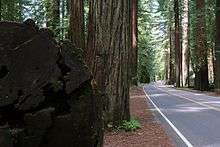List of California native plants
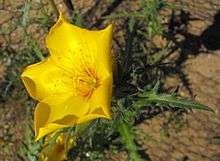
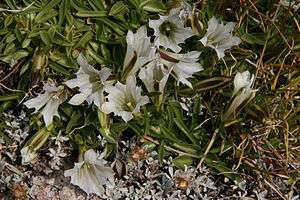
California native plants are plants that existed in California prior to the arrival of European explorers and colonists in the late 18th century.[1] California includes parts of at least three phytochoria. The largest is the California Floristic Province, a geographical area that covers most of California, portions of neighboring Oregon, Nevada, and Baja California, and is regarded as a "world hotspot" of biodiversity.[2][3]
Introduction
In 1993 The Jepson Manual estimated that California was home to 4,693 native species and 1,169 native subspecies or varieties, including 1,416 endemic species. A 2001 study by the California Native Plant Society estimated 6,300 native plants. These estimates continue to change over time.[2]
Of California's total plant population, 2,153 species, subspecies, and varieties are endemic and native to California alone, according to the 1993 Jepson Manual study.[4] This botanical diversity stems not only from the size of the state, but also its diverse topographies, climates, and soils (e.g. serpentine outcrops). Numerous plant groupings exist in California, and botanists work to structure them into identifiable ecoregions, plant communities, vegetation types, and habitats, and taxonomies.[4][5]
California native plants include some that have widespread horticultural use. Sometimes the appreciation began outside of California—lupines, California fuchsias, and California poppies were first cultivated in British and European gardens for over a century.[6]
Selected trees
Coniferous trees
Sequoias and redwoods
- Coast redwood (Sequoia sempervirens) - in the fog-shrouded coast ranges.
- Giant sequoia (Sequoiadendron giganteum) - in the Sierra Nevada Mountains.
Pine trees
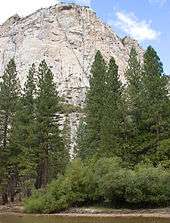
- Bishop pine (Pinus muricata) - coastal species - gardens.
- Coulter pine (Pinus coulteri)
- Gray pine - digger pine (Pinus sabiniana)
- Knobcone pine (Pinus attenuata)
- Ponderosa pine (Pinus ponderosa) - well known in mountains
- Lodgepole pine (Pinus_contorta) - use for early construction of buildings and other structures
- Monterey pine (Pinus radiata) - naturally limited endemic - widely planted horticulturally around the world.
- Limber pine (Pinus flexilis)
- Jeffrey pine (Pinus jeffreyi)
- Parry pinyon (Pinus quadrifolia)
- Shore pine (Pinus contorta)
- Sugar pine (Pinus lambertiana)
- Torrey pine (Pinus torreyana)
- Western white pine (Pinus monticola)
- Single-leaf pinyon pine (Pinus monophylla)
- Great Basin bristlecone pine (Pinus longaeva) - the 'Methuselah' - 4,700 years old.
- Foxtail pine (Pinus balfouriana) - Californian endemic; 2,000-year-old specimens.
Other conifers
- Monterey cypress (Cupressus macrocarpa)
- Santa Lucia fir (Abies bracteata) and seven other native Abies species.
- Douglas-fir (Pseudotsuga menziesii)
- Bigcone Douglas-fir (Pseudotsuga macrocarpa) - Central Coast and Santa Susana Mountains.
- California nutmeg (Torreya californica)
- Incense cedar (Calocedrus decurrens)
- Port Orford cedar-Lawson cypress (Chamaecyparis lawsoniana)
- White fir (Abies concolor) - at high elevations
- Mountain hemlock (Tsuga mertensiana)
- Red fir (Abies magnifica)
Oak trees
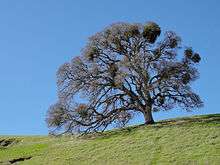
- California is home to many deciduous and evergreen oaks, often occurring in oak woodlands:
- Valley oak (Quercus lobata) - the giant.
- Leather oak (Quercus durata) - the shrubby one
- Blue oak (Quercus douglasii) - in the Central Valley foothills and Coast Ranges
- California black oak (Quercus kelloggii) - in the higher hills mountains
- Canyon live oak (Quercus chrysolepis) - in the higher hills
- Interior live oak (Quercus wislizenii) in the Central Valley region.
- Island oak (Quercus tomentella) - endemic with distinctive large evergreen leaves.
- Engelmann oak (Quercus engelmanni) - shade giving with a cool blue-gray cast to the foliage.
- Coast live oak (Quercus agrifolia) is found in the Coast Ranges, Transverse Ranges, Peninsular Ranges, and along the coast's hills and adjacent interior valleys, and many other habitats and gardens.[7][8]
Riparian trees
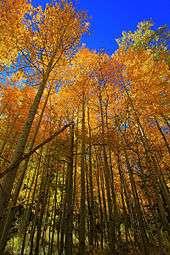
- In riparian areas (streamside and moist habitats) some of the trees include:
- California sycamore (Platanus racemosa)
- White alder (Alnus rhombifolia)
- Quaking aspen (Populus tremuloides)
- Fremont cottonwood (Populus fremontii)
- Black cottonwood (Populus trichocarpa).
- Arroyo willow (Salix lasiolepis).[9]
- Tanoak (Lithocarpus densiflorus)
- California bay laurel (Umbellularia californica)
- Madrone (Arbutus menziesii)
- Toyon (Heteromeles arbutifolia)
- Bigleaf maple (Acer macrophyllum)
- Western blue elderberry (Sambucus mexicana) is found throughout the state, an important host for birds, butterflies, pollinators, and beneficial insects (integrated pest management).
- California Buckeye (Aesculus californica)
- Western redbud (Cercis occidentalis)
- California black walnut (Juglans californica)
- California hazelnut (Corylus cornuta)
Selected shrubs
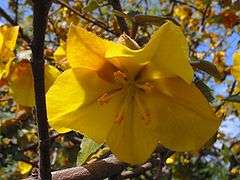
- Chamise or greasewood (Adenostoma fasciculatum)
- Service-berry (Amelanchier alnifolia)
- Manzanita (Arctostaphylos spp.)
- Coyote brush (Baccharis pilularis)
- California lilacs (Ceanothus spp.)
- Flannelbush (Fremontodendron spp.)
- Creosote bush (Larrea tridentata)
- Lupines (Lupinus spp.)
- Snowberry (Symphoricarpos mollis & spp.),
- Huckleberry (Vaccinium ovatum & spp.)
- Coffeeberry (Rhamnus spp.)
- Lemonade berry (Rhus integrifolia)
- Sugarbush (Rhus ovata)
- Gooseberries and currants (Ribes spp.)
- Sages (Salvia spp.)[10][11]
Selected desert plants
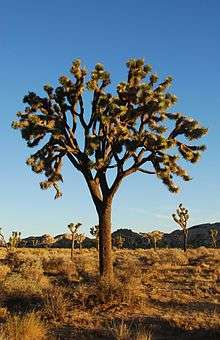
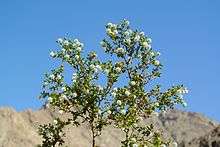
- California fan palm (Washingtonia filifera)
- Joshua tree (Yucca brevifolia)
- California juniper (Juniperus californica)
- Blue palo verde (Parkinsonia florida)
- Yellow foothill palo verde (Parkinsonia microphylla)
- Single-leaf pinyon (Pinus monophylla)
- Fremont cottonwood (Populus fremontii)
- Ocotillo (Fouquieria splendens)
- Creosote bush (Larrea tridentata)
- Indian mallow (Abutilon palmeri)
- Brittlebush (Encelia farinosa)
- Desert agave (Agave deserti)
- California barrel cactus (Ferocactus cylindraceus)
- Banana yucca (Yucca baccata)
- Mojave yucca (Yucca schidigera)
- Rush milkweed (Asclepias subulata)
- Purple desert sand-verbena (Abronia villosa)
- Sacred datura (Datura wrightii)
Selected perennials
.jpg)
Sunny habitats
- California poppy (Eschscholzia californica) are found in drier places. California poppies are also an annual in many places.
- Douglas iris (Iris douglasiana) and 'Pacific Coast' hybrids
- Monkeyflower e.g.: Mimulus aurantiacus, Mimulus guttatus, Mimulus cardinalis and cultivars.
- Columbine (Aquilegia spp.)
- Coyote mint (Monardella spp.)
- Buckwheats (Eriogonum fasciculatum), (Eriogonum giganteum), (Eriogonum umbellatum)
Shady habitats
- Western wild ginger (Asarum caudatum)
- Pacific bleeding-heart (Dicentra formosa)
- Island coral bells (Heuchera maxima)
- Canyon coral bells (Heuchera hirsutissima)
- Heucherella
- Threeleaf foamflower (Tiarella trifoliata)
- Redwood sorrel (Oxalis oregana)[12]
Ferns
- Polypody ferns (Polypodium), e.g.: Polypodium californicum
- Native sword ferns (Polystichum), e.g.: Polystichum munitum
- Giant chain fern (Woodwardia fimbriata)
- Goldback ferns (Pteridium spp.)
- Wood ferns (Dryopteris spp.), e.g.: Dryopteris arguta
- Maidenhair ferns (Adiantum spp.) e.g.: Adiantum jordanii
Selected bulbs
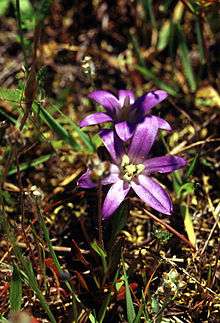
- Ithuriel's spear (Triteleia spp.)
- Meadow onion (Allium monticola)
- Goldenstars (Bloomeria crocea)
- Brodiaeas (Brodiaea spp.)
- Blue dicks-ookow (Dichelostemma capitatum): one of the most common native bulb species throughout California; found in grassland and dry meadow habitats
- Mariposa lilies (Calochortus spp.): available from reputable horticultural sources; taking from the wild is illegal and is resulting in significant declines of some species from over collecting.
Selected annuals and wildflowers
- Baby blue eyes (Nemophila menziesii)
- Blazing star (Mentzelia lindleyi)
- California poppy (Eschscholzia californica)
- Chinese houses (Collinsia heterophylla)
- Elegant clarkia (Clarkia unguiculata)
- Farewell-to-spring (Clarkia amoena)
- Meadowfoam (Limnanthes douglasii)
- Miner's lettuce (Claytonia perfoliata)
- Tarweed (Madia elegans)
- Wind poppy (Stylomecon heterophylla)[13]
Selected vines

- Dutchman's pipe vine (Aristolochia spp.)
- Morning glory (Calystegia spp.)
- Chaparral clematis (Clematis lasiantha)
- Western virgin's bower (Clematis ligusticifolia)
- Calabazilla (Cucurbita foetidissima)
- Wild cucumber-manroot (Marah fabaceus)
- Cucamonga manroot-bigroot (Marah macrocarpus)
- California wild grape (Vitis californica)
- Desert wild grape (Vitis girdiana)
Selected grasses
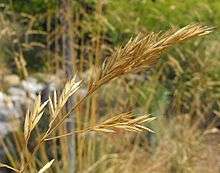
- Grasses:[14]
- Purple three-awn (Aristida purpurea)
- Blue grama (Bouteloua gracilis)
- California fescue (Festuca californica)
- Idaho fescue (Festuca idahoensis)
- Red fescue (Festuca rubra)
- Junegrass (Koeleria macrantha)
- Giant wildrye (Leymus condensatus)
- California melic (Melica californica)
- Deer grass (Muhlenbergia rigens)
- Purple needlegrass (Nassella pulchra): The state grass of California
- Indian ricegrass (Oryzopsis hymenoides)
- Pine bluegrass (Poa secunda)
- Grasslike:[15]
- Sedges — (Carex spp.) (taller 'bunch grass' specimens and lower meadow spreaders)
- Rushes — (Juncus spp.)
- Western blue-eyed grass (Sisyrinchium bellum) and yellow-eyed-grass (Sisyrinchium californicum).
Selected succulents
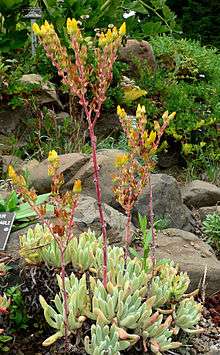
- Chalk lettuce (Dudleya pulverulenta) - garden-plant
- Coast dudleya (Dudleya caespitosa) - [CA endemic]
- Canyon live-forever (Dudleya cymosa) - garden-plant
- Fingertips (Dudleya edulis) - garden-plant
- Giant chalk dudleya, Britton's dudleya (Dudleya brittonii) - garden-plant
- Lanceleaf liveforever (Dudleya lanceolata) - garden-plant
- Broadleaf stonecrop (Sedum spathulifolium) - San Bruno elfin butterfly host plant.
- Coast sedum (Sedum oreganum)
- Feather River stonecrop (Sedum albomarginatum) - [CA endemic, Sierras]
- Red Mountain stonecrop (Sedum eastwoodiae) - [CA endemic, Mendocino]
- Roseflower stonecrop (Sedum laxum)
- Sierra stonecrop (Sedum obtusatum)
Environmental challenges
Some California native plants are in rapid decline in their native habitat due to urban sprawl, agriculture, overgrazing, recreational impacts, pollution, and invasive non-native species (invasive exotics) colonization pressures (animals and other kingdoms of life, as well as plants).[16]
California also has 1,023 species of non-native plants, some now problematic invasive species such as yellow starthistle, that were introduced during the Spanish colonization, the California Gold Rush, and subsequent immigrations and import trading of the 18th, 19th and 20th centuries.
See also
References
- ↑ "What is a native plant?". California Native Plant Society. Retrieved 2009-06-02.
- 1 2 Ornduff, Robert; Faber, Phyllis M.; Keeler-Wolf, Todd (2003). Introduction to California Plant Life. University of California Press. ISBN 978-0-520-23704-9. Retrieved 28 January 2013.
- ↑ "California Floristic Province". Biodiversity Hotspots. Conservation International. Retrieved 2009-06-02.
- 1 2 Hickman, J.C., ed. (1993). "Appendix I". The Jepson Manual, Higher Plants of California. University of California Press. p. 1315.
- ↑ Munz, Philip Alexander; Keck, David Daniels (1 June 1973). A California Flora. University of California Press. ISBN 978-0-520-02405-2. Retrieved 28 January 2013.
- ↑ Bornstein, Carol; Fross, David; O'Brien, Bart (1 December 2005). California native plants for the garden. Cachuma Press. ISBN 978-0-9628505-8-5. Retrieved 28 January 2013.
- ↑ Pavlik, Bruce M.; Muick, Pamela; Johnson, Sharon (1993). Oaks of California. Cachuma Press. ISBN 978-0962850516.
- ↑ Jepson Manual Quercus agrifolia
- ↑ Jepson Manual Salix lasiolepsis
- ↑ Keator, Glenn (1 March 1994). Complete Garden Guide to the Native Shrubs of California. Chronicle Books. ISBN 978-0-8118-0402-8. Retrieved 28 January 2013.
- ↑ Fross, David; Wilken, Dieter (1 February 2006). Ceanothus. Timber Press. ISBN 978-0-88192-762-7. Retrieved 28 January 2013.
- ↑ Keator, Glenn (1990). Complete Garden Guide to the Native Perennials of California. Chronicle Books. ISBN 978-0-87701-699-1. Retrieved 28 January 2013.
- ↑ "Theodore Payne Foundation for Wildflowers and Native Plants".
- ↑ "California Native Grasslands Association". Retrieved 9 June 2010.
- ↑ Crampton, Beecher (1974). Grasses in California. University of California Press. ISBN 978-0-520-02507-3. Retrieved 28 January 2013.
- ↑ Alden, Peter; Heath, Fred (26 May 1998). Field Guide to California. Knopf. National Audubon Society. ISBN 978-0-679-44678-1. Retrieved 28 January 2013.
Further reading
Books: flora
- A California Flora and Supplement, Philip A. Munz and David D. Keck, UC Press
- Grasses in California, Beecher Crampton, UC Press
- The Jepson Manual: Higher Plants of California, James C. Hickman (Editor), UC Press
- The Jepson Desert Manual: Vascular Plants of Southeastern California, Bruce Baldwin (Editor), UC Press
- Oaks of California, Bruce M. Pavlik, Pamela Muick, Sharon Johnson, Cachuma Press
- Plants of the San Francisco Bay Region: Mendocino to Monterey, Linda Beidleman, Eugene Kozloff, UC Press
Books: gardening/landscaping
- Landscape Plants for California Gardens, Bob Perry, Land Design Publishing
- California Native Plants for the Garden, Carol Bornstein, David Fross, and Bart O'Brien, Cachuma Press
- California Native Trees and Shrubs, Lee W. Lenz, Rancho Santa Ana
- Ceanothus, David Fross and Dieter Wilken, Timber Press
- Complete Guide to Native Perennials of California, Glenn Keator, Chronicle Books
- Complete Guide to Native Shrubs of California, Glenn Keator, Chronicle Books
- Designing California Native Gardens: The Plant Community Approach to Artful, Ecological Gardens, Glenn Keator and Alrie Middlebrook, UC Press
- Growing California Native Plants, Marjorie Schmidt, UC Press
- Native Landscaping From El Paso to L.A., Sally Wasowski and Andy Wasowski, McGraw-Hill
- Native Plants for California Gardens, Lee W. Lenz, Day Printing Corp.
- Native Treasures: Gardening with the Plants of California, M. Nevin Smith, UC Press
External links
| Wikimedia Commons has media related to: |
- CNPS—California Native Plant Society website
- CalFlora Database — extensive searchable database of California native plants.
- Jepson Manual 'Flora Interchange' — extensive database of California native plants
- U.C. CalPhotos: Flora homepage — searchable images database
- Theodore Payne Foundation for Wildflowers and Native Plants — including horticultural information
- California Native Grasslands Association — including bunchgrass species and habitats
